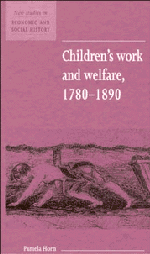3 - Rescue and reform: 1830–1867
Published online by Cambridge University Press: 04 August 2010
Summary
State intervention: its scope and limitations
It is erroneous to assume that there were no constraints on juvenile wage labour before the State intervened, through its factory and workshop legislation, to impose such restrictions. Apart from the absence of jobs suitable for youngsters in a number of industries, parental choice and economic circumstances played a major role. In large families while the eldest children might be set to work from the earliest possible age, a different approach could be adopted towards their younger siblings. Again, in the case of girls, these might be kept at home to assist with domestic chores and to look after the younger children, perhaps because their mother was at work or because she was ill or overburdened. As such they were omitted from official employment statistics, even though many were occupied for long hours in drudging toil.
In textiles, technical change had already reduced the importance of juveniles even before effective legislation to regulate their employment was enacted in the 1830s (Nardinelli, 1980). Quantitatively the statutory controls of that decade had a very limited effect, since relatively few working children fell into the age and occupational categories which were barred. In 1833, before the application of the Factory Act of that year, children under 9 (the age chosen for exclusion) comprised a mere 0.03 per cent of the cotton labour force and 1.02 per cent of that in wool.
- Type
- Chapter
- Information
- Children's Work and Welfare 1780–1890 , pp. 35 - 58Publisher: Cambridge University PressPrint publication year: 1995



